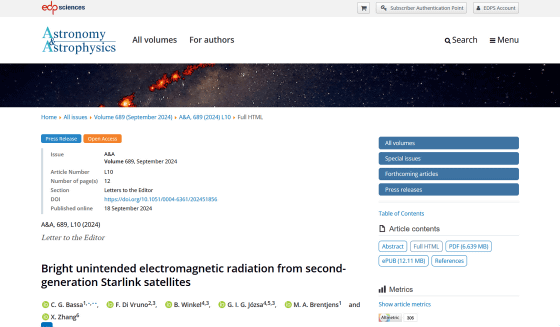The second generation of Starlink satellites emits 32 times more radio waves than the first generation, which could disrupt astronomical observations using radio telescopes

Starlink, which develops satellite internet, has launched many artificial satellites to expand its services, and
Bright unintended electromagnetic radiation from second-generation Starlink satellites | Astronomy & Astrophysics (A&A)
https://www.aanda.org/articles/aa/full_html/2024/09/aa51856-24/aa51856-24.html

Second-Generation Starlink Satellites Leak 30 Times More Radio Interference, Threatening Astronomical Observations | ASTRON
https://www.astron.nl/starlink-satellites/
Starlink Satellites Risk Blotting Out Radio Telescopes, Astronomers Warn | PCMag
https://www.pcmag.com/news/starlink-satellites-risk-blotting-out-radio-telescopes-astronomers-warn
In recent years, with the commercialization of space development and advances in satellite technology, the number of satellites launched into low Earth orbit (LEO) is increasing. This trend is being driven by companies that provide satellite internet services, such as SpaceX, which develops Starlink, and OneWeb .
According to the plans of companies that have been revealed so far, the number of artificial satellites floating in low Earth orbit could exceed 100,000 within the next 10 years. However, artificial satellites do not just fly, but also emit radio waves from their bodies, so there are concerns that this will have a negative impact on the accuracy of radio telescopes that use radio waves to observe celestial bodies.
So a research team led by Kees Bassa of the Netherlands Institute for Radio Astronomy (ASTRON) conducted an experiment using the Low Frequency Array (LOFAR) , a giant radio telescope, to observe specific radio bands for one hour. LOFAR is a collection of multiple stations with densely packed antennas, most of which are located in the Netherlands, but there are also stations in other European countries, including Germany, the UK, France, and Sweden.

In this experiment, many Starlink satellites crossed the observation range during the one-hour observation, and unintentional radio emissions were detected from almost all of them.
In the video below, the left side shows the radio emission observed by LOFAR, and the right side shows the radio emission emphasized by subtracting the median pixel value. The red dots show the radio emission from the satellite, which can be seen as a light source moving across the night sky.
LOFAR observations of Starlink V2 mini satellites - YouTube
The analysis also revealed that the radio waves emitted by the satellites differ depending on the generation. The second generation Starlink satellites emit up to 32 times more radio waves than the first generation. Compared to the faintest celestial object observed by LOFAR, the radio emissions of Starlink satellites are 10 million times brighter, which is equivalent to the difference between the faintest star visible to the naked eye and the brightest full moon.
'We have begun a program using LOFAR to monitor for unintended radio emissions from satellites in different star systems. Our observations show that the second-generation Starlink satellites emit stronger and wider ranges of radio waves than the first-generation satellites,' Bassa said. 'This problem is getting worse as SpaceX launches about 40 second-generation Starlink satellites per week.'
'We are clearly approaching an inflection point where we must act to protect the sky as our window into space,' said Federico Bruno, co-author of the paper and head of the SKA Observatory . 'Satellite companies don't want to be the ones generating these unintended radio waves, so minimizing radio emissions should be a priority in any sustainable space policy. Starlink is not the only big player in low Earth orbit, but they have the opportunity to set the standard here.'
Related Posts:







